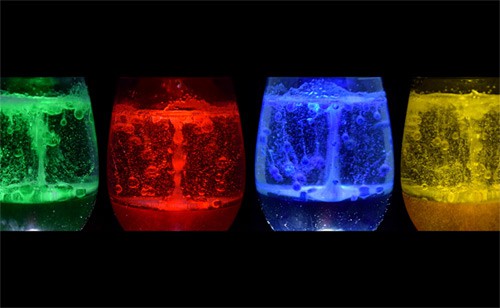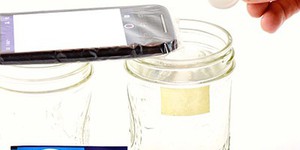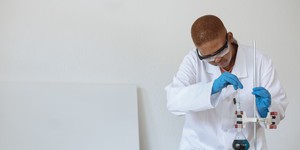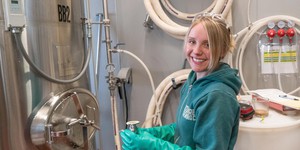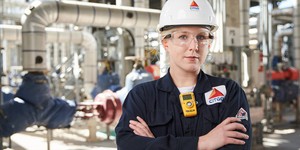Summary
Introduction
Have you ever seen a lava lamp? They were the height of 1960's "groovy" room decorations. A few minutes after turning it on, a lava lamp has blobs of colored liquid floating towards the top of the lamp and then drifting back down. Making an actual lava lamp that you plug in would require some effort and unusual supplies, but you can create a non-electric version in just a few minutes with the help of the fizzing power of Alka-Seltzer. In this activity you can find out how to make your own Alka-Seltzer® lava lamp. How will changing the temperature of the ingredients change the behavior of the colorful blobs in your lava lamp?Materials
- Tall identical jars or bottles, such as empty, clear, plastic 1-liter or 2-liter bottles (2)
- Knife
- Cutting board
- Timer or clock that shows seconds
- Water
- Food coloring
- Vegetable oil (enough to fill the jars nearly full)
- An Alka-Seltzer tablet. Only one tablet is needed for the activity, but having additional tablets can be fun if you wanted to repeat lava lamp action.
- A way to make one jar hot and one cold, such as by using a large bowl filled with hot water and access to a refrigerator or freezer
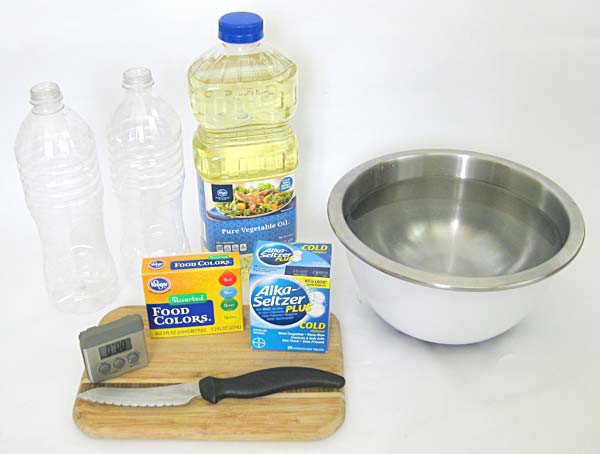 Image Credit: Teisha Rowland, Science Buddies / Science Buddies
Image Credit: Teisha Rowland, Science Buddies / Science Buddies
Instructions
- To each jar or bottle, fill it with 1-2 inches of water, add 5 drops of food coloring, and then fill it at least three-quarters full with vegetable oil. Put the cap on tightly to avoid spills and leaks.
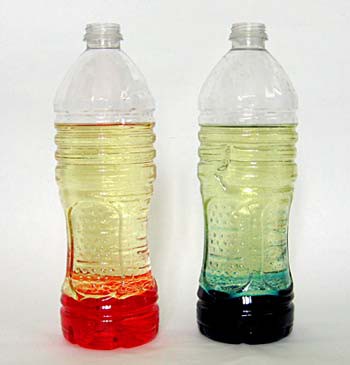 Image Credit: Teisha Rowland, Science Buddies / Science Buddies
Image Credit: Teisha Rowland, Science Buddies / Science Buddies
- Somehow make one of the prepared jars be hot and one be cold. For example, to make one hot you could let it sit in a large bowl of hot water, and to make one cold you could store it in a refrigerator or freezer. Be careful when handling hot water.
- While you are heating and cooling the jars, cut an Alka-Seltzer tablet into quarters. Only two quarter pieces are needed for the activity, but having additional pieces can be fun if you wanted to repeat lava lamp action.
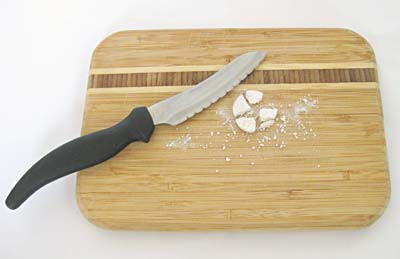 Image Credit: Teisha Rowland, Science Buddies / Science Buddies
Image Credit: Teisha Rowland, Science Buddies / Science Buddies
- Once one jar is hot and one is cold, get a timer or clock ready and drop a quarter of a tablet into the heated jar. Note that the tablet piece may take a moment to sink through the vegetable oil to reach the water, where it will react. Start timing as soon as the tablet piece reaches the water and starts reacting.How long does it take the tablet to disappear? How vigorous are the bubbles?
 Image Credit: Teisha Rowland, Science Buddies / Science Buddies
Image Credit: Teisha Rowland, Science Buddies / Science Buddies
- Now drop a quarter of a tablet in the cold jar. Time how long it takes the tablet to disappear this time.How long does it take the tablet to disappear in the colder liquid?
- Think about how the two reactions looked.Do you notice other differences in how the reaction happens in the colder liquid versus in the hotter liquid? Why do you think you got the results that you did?
Cleanup
- When you are done playing with the lava lamps, do not pour them down the drain. That quantity of vegetable oil can lead to clogs in the sewer system. Instead, pour the contents of the lava lamps into a compost pile or dig a hole in your yard, away from any plants you care about, and pour the contents in the hole. If neither of those are an option, simply screw the cap on tightly and throw the lava lamp jar in your regular trash.
What Happened?
The ingredients in Alka-Seltzer combine with water to form a gas called carbon dioxide. The oil and Alka-Seltzer do not combine in this way though. The Alka-Seltzer tablets sink through the vegetable oil until they reach the layer of colored water. There the Alka-Seltzer dissolves in the water and forms a gas called carbon dioxide. The gas is lighter than the water and oil, so it bubbles up, taking a bit of colored water with it as it moves through the oil layer. You should have seen those bubbles, looking like colorful blobs, float through the oil layer to the top of the jar. At the top the bubbles should have burst (releasing the carbon dioxide gas), and then the colorful blobs should have sunk back to the bottom (now without carbon dioxide gas). The effect should have been reminiscent of a lava lamp.
The chemical reaction that causes the carbon dioxide to form happens more quickly in warmer water. For this reason, you should have seen that the Alka-Seltzer tablet dissolved more quickly in the hot water, in approximately 20-30 seconds depending on the temperature. This should have resulted in lots of rapid bubbling and an energetic lava lamp display. In contrast, the Alka-Seltzer tablet in the cold water should have dissolved more slowly, with most of it should disappearing in the first two to three minutes, resulting in a calmer and longer lasting lava lamp effect.
Digging Deeper
Alka-Seltzer is a medical drug that works as a pain reliever and an antacid (antacids help neutralize stomach acidity, such as heartburn). The pain reliever used is aspirin and the antacid used is baking soda, or sodium bicarbonate. To take the tablets, they are fully dissolved in water, where they famously undergo a chemical reaction that produces lots of carbon dioxide bubbles. Why is this? As the tablets dissolve, the sodium bicarbonate splits apart to form sodium and bicarbonate. The bicarbonate reacts with hydrogen (from citric acid, another ingredient in the tablets) to form carbon dioxide gas (and water). This is how the bubbles are made.
How is temperature related to this reaction? For the reaction to occur, the bicarbonate must come into contact with the hydrogen in just the right way. The chance of the bicarbonate and hydrogen doing this is affected by temperature: the higher the temperature, the faster the molecules move; the lower the temperature, the slower they move. The faster they move, the more likely they are to come into contact with each other.
Ask an Expert
For Further Exploration
- Test Alka-Seltzer tablets in a wider range of temperatures, and then graph the time it takes a tablet to dissolve in water at each temperature (check with a thermometer). What temperature change is required to increase the reaction time by a factor of two? What about decreasing the reaction time by a factor of two?
- Compare whole Alka-Seltzer tablets to pieces of Alka-Seltzer tablets. If there is a greater surface area (i.e., a tablet is broken up into more pieces), does the same amount of tablet result in the reaction happening faster or slower, or in a different way?



